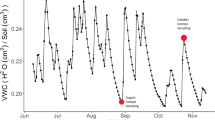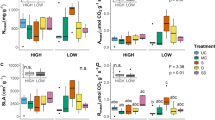Abstract
Ecosystem water-use efficiency (eWUE; the ratio of net ecosystem productivity to evapotranspiration rate) is a complex landscape-scale parameter controlled by both physical and biological processes occurring in soil and plants. Leaf WUE (lWUE; the ratio of leaf CO2 assimilation rate to transpiration rate) is controlled at short time scales principally by leaf stomatal dynamics and this control varies among plant species. Little is known about how leaf-scale variation in lWUE influences landscape-scale variation in eWUE. We analyzed approximately seven thousand 30-min averaged eddy covariance observations distributed across 9 years in order to assess eWUE in two neighboring forest communities. Mean eWUE was 19% lower for the community in which Engelmann spruce and subalpine fir were dominant, compared to the community in which lodgepole pine was dominant. Of that 19% difference, 8% was attributed to residual bias in the analysis that favored periods with slightly drier winds for the spruce-fir community. In an effort to explain the remaining 11% difference, we assessed patterns in lWUE using C isotope ratios. When we focused on bulk tissue from older needles we detected significant differences in lWUE among tree species and between upper and lower canopy needles. However, when these differences were scaled to reflect vertical and horizontal leaf area distributions within the two communities, they provided no power to explain differences in eWUE that we observed in the eddy covariance data. When we focused only on bulk needle tissue of current-year needles for 3 of the 9 years, we also observed differences in lWUE among species and in needles from upper and lower parts of the canopy. When these differences in lWUE were scaled to reflect leaf area distributions within the two communities, we were able to explain 6.3% of the differences in eWUE in 1 year (2006), but there was no power to explain differences in the other 2 years (2003 and 2007). When we examined sugars extracted from needles at 3 different times during the growing season of 2007, we could explain 3.8–6.0% of the differences in eWUE between the two communities, but the difference in eWUE obtained from the eddy covariance record, and averaged over the growing season for this single year, was 32%. Thus, overall, after accounting for species effects on lWUE, we could explain little of the difference in eWUE between the two forest communities observed in the eddy covariance record. It is likely that water and C fluxes from soil, understory plants, and non-needle tissues, account for most of the differences observed in the eddy covariance data. For those cases where we could explain some of the difference in eWUE on the basis of species effects, we partitioned the scaled patterns in lWUE into two components: a component that is independent of canopy leaf area distribution, and therefore only dependent on species-specific differences in needle physiology; and a component that is independent of species differences in needle physiology, and only dependent on species-specific influences on canopy leaf area distribution. Only the component that is dependent on species influences on canopy leaf area distribution, and independent of inherent species differences in needle physiology, had potential to explain differences in eWUE between the two communities. Thus, when tree species effects are important, canopy structure, rather than species-specific needle physiology, has more potential to explain patterns in eWUE.







Similar content being viewed by others
References
Berry SC, Varney GT, Flanagan LB (1997) Leaf δ13C in Pinus resinosa trees and understory plants: variation associated with light and CO2 gradients. Oecologia 109:499–506
Bolstad PV, Davis KJ, Martin J, Cook BD, Wang W (2004) Component and whole-system respiration fluxes in northern deciduous forests. Tree Physiol 24:493–504
Bonan GB (1996) A land surface model (LSM version 1.0) for ecological, hydrological, and atmospheric studies: technical description and user’s guide. National Center for Atmospheric Research, Boulder
Carter GA, Smith WK (1985) Influence of shoot structure on light interception and photosynthesis in conifers. Plant Physiol 79:1038–1043
Cescatti A, Niinemets U (2004) Sunlight capture: leaf to landscape. In: Smith WK, Vogelmann TC, Chritchley C (eds) Photosynthetic adaptation: chloroplast to landscape. Ecological studies, vol 178. Springer, Berlin, pp 42–85
Chen JM, Rich PM, Gower ST, Norman JM, Plummer S (1997) Leaf area index of boreal forests: theory, techniques, and measurements. J Geophys Res 102(D24):29429–29443
Del Grosso S, Parton W, Stohlgren T, Zheng DL, Bachelet D, Prince S, Hibbard K, Olson R (2008) Global potential net primary production predicted from vegetation class, precipitation, and temperature. Ecology 89:2117–2126
Domingues TF, Martinelli LA, Ehleringer JR (2006) Ecophysiological traits of plant functional groups in forest and pasture ecosystems from eastern Amazonia, Brazil. Plant Ecol 193:101–112
Duursma RA, Marshall JD (2006) Vertical canopy gradients in δ13C correspond with leaf nitrogen content in a mixed-species conifer forest. Trees Struct Funct 20:496–506
Emmerich WE (2007) Ecosystem water use efficiency in a semiarid shrubland and grassland community. Rangeland Ecol Manage 60:464–470
Farquhar GD, Ehleringer JR, Hubick KT (1989) Carbon isotope discrimination and photosynthesis. Annu Rev Plant Physiol Plant Mol Biol 40:503–537
Fassnacht KS, Gower ST, Norman JM, McMurtrie RE (1994) A comparison of optical and direct methods for estimating foliage surface area index in forests. Agric For Meteorol 71:183–207
Francey RJ, Gifford RM, Sharkey TD, Weir B (1985) Physiological influences on carbon isotope discrimination in huon pine (Lagorostrobos franklinii). Oecologia 66:211–218
Gessler A, Schrempp S, Matzarakis A, Mayer H, Rennenberg H, Adams MA (2001) Radiation modifies the effect of water availability on the carbon isotope composition of beach (Fagus sylvatica). New Phytol 150:653–664
Golluscio RA, Oesterheld M (2007) Water use efficiency of twenty-five co-existing Patagonian species growing under different soil water availability. Oecologia 154:207–217
Gonzalez-Rodriguez AM, Morales D, Jimenez MS (2002) Leaf gas exchange characteristics in relation to leaf canopy position of Myrica faya in its native environment (Tenerife, Canary Islands). Plant Biol 4:576–583
Goulden ML, Wofsy SC, Harden JW, Trumbore SE, Crill PM, Gower ST, Fries T, Daube BC, Fan SM, Sutton DJ, Bazzaz A, Munger JW (1998) Sensitivity of boreal forest carbon balance to soil thaw. Science 279:214–217
Gu LH, Fuentes JD, Shugart HH, Staebler RM, Black TA (1999) Responses of net ecosystem exchanges of carbon dioxide to changes in cloudiness: results from two North American deciduous forests. J Geophys Res Atmos 104:31421–31434
Hooper DU, Chapin FS, Ewel JJ, Hector A, Inchausti P, Lavorel S et al (2005) Effects of biodiversity on ecosystem functioning: a consensus of current knowledge. Ecol Monogr 75:3–35
Jansson PE, Svensson M, Kleja DB, Gustafsson D (2008) Simulated climate change impacts on fluxes of carbon in Norway spruce ecosystems along a climatic transect in Sweden. Biogeochemistry 89:81–94
Knohl A, Baldocchi DD (2008) Effects of diffuse radiation on canopy gas exchange processes in a forest ecosystem. J Geophys Res Biogeosci 113:G02023
Law BE, Williams M, Anthoni PM, Baldocchi DD, Unsworth MH (2000) Measuring and modelling seasonal variation of carbon dioxide and water vapour exchange of a Pinus ponderosa forest subject to soil water deficit. Glob Change Biol 6:613–630
Law BE, Falge E, Gu L et al (2002) Environmental controls over carbon dioxide and water vapor exchange of terrestrial vegetation. Agric For Meteorol 113:97–120
Le Roux X, Bariac T, Sinoquet H, Genty B, Piel C, Mariotti A, Girardin C, Richard P (2001) Spatial distribution of leaf water-use efficiency and carbon isotope discrimination within an isolated tree crown. Plant Cell Environ 24:1021–1032
Lee MS, Mo WH, Koizumi H (2006) Soil respiration of forest ecosystems in Japan and global implications. Ecol Res 6:828–839
Monson RK, Turnipseed AA, Sparks JP, Harley PC, Scott-Denton LE, Sparks K, Huxman TE (2002) Carbon sequestration in a high-elevation, subalpine forest. Glob Change Biol 8:459–478
Niinemets U, Sonninen E, Tobias M (2004) Canopy gradients in leaf intercellular CO2 mole fractions revisited: interactions between leaf irradiance and water stress need consideration. Plant Cell Environ 27:569–583
Peters J, Gonzalez-Rodriguez AM, Jimenez MS, Morales D, Wieser G (2008) Influence of canopy position, needle age and season on the foliar gas exchange of Pinus canariensis. Eur J For Res 127:293–299
Ponton S, Flanagan LB, Alstad KP, Johnson BG, Morgenstern K et al (2006) Comparison of ecosystem water-use efficiency among Douglas-fir forest, aspen forest and grassland using eddy covariance and carbon isotope techniques. Glob Change Biol 12:294–310
Pyles RD, Weare BC, Paw UKT (2000) The UCD advanced canopy-atmosphere-soil algorithm: comparisons with observations from different climate and vegetation regimes. Q J R Meteorol Soc 126:2951–2980
Reichstein M, Tenhunen JD, Roupsard O, Ourcival JM, Rambal S et al (2002) Severe drought effects on ecosystem CO2 and H2O fluxes at three Mediterranean evergreen sites: revision of current hypotheses? Glob Change Biol 8:999–1017
Richardson AD, Hollinger DY, Burba GG, Davis KJ, Flanagan LB, Katul GG, Munger JW, Ricciuto DM, Stoy PC, Suyker AE, Verma SB, Wofsy SC (2006) A multi-site analysis of random error in tower-based measurements of carbon and energy fluxes. Agric For Meteorol 136:1–18
Sacks WJ, Schimel DS, Monson RK, Braswell BH (2006) Model-data fusion analysis of ecosystem respiration at the Niwot Ridge Ameriflux site. Glob Change Biol 12:240–259
Schaeffer SM, Anderson DE, Burns SP, Monson RK, Sun J, Bowling DR (2008) Canopy structure and atmospheric flows in relation to the δ13C of respired CO2 in a subalpine coniferous forest. Agric For Meteorol 148:592–605
Schoettle AW, Fahey TJ (1994) Foliage and fine root longevity of pines. Ecol Bull 43:136–153
Seibt U, Rajabi A, Griffiths H, Berry JA (2008) Carbon isotopes and water use efficiency: sense and sensitivity. Oecologia 155:441–454
Sellers PJ, Randall DA, Collatz GJ et al (1996) A revised land surface parameterization (SiB2) for atmospheric GCMs. Part I. Model formulation. J Clim 9:676–705
Terashima I, Hanba YT, Tazoe Y, Vyas P, Yano S (2006) Irradiance and phenotype: comparative eco-development of sun and shade leaves in relation to photosynthetic CO2 diffusion. J Exp Bot 57:342–354
Turnipseed AA, Anderson DE, Blanken PD, Baugh WM, Monson RK (2003) Airflows and turbulent flux measurements in mountainous terrain. Part 1. Canopy and local effects. Agric For Meteorol 119:1–21
Warren CR, Ethier GJ, Livingston NJ, Grant NJ, Turpin DH, Harrison DL, Black TA (2003) Transfer conductance in second growth Douglas-fir (Pseudotsuga menziesii (Mirb.)Franco) canopies. Plant Cell Environ 26:1215–1227
Yi C, Anderson DE, Turnipseed AA, Burns SP, Sparks JP, Stannard DI, Monson RK (2008) The contribution of advective fluxes to net ecosystem CO2 exchange in a high-elevation, subalpine forest. Ecol Appl 18:1379–1390
Yu M, Gao Q, Epstein HE, Zhang XS (2008) An ecohydrological analysis for optimal use of redistributed water among vegetation patches. Ecol Appl 18:1679–1688
Acknowledgments
This research was supported with funds from the National Institute for Climate Change Research (award MPC35TX-A2) administered by Northern Arizona University, and a grant from the U.S. National Science Foundation (grant EAR 0321918). We would like to thank Jeff Beauregard and Kelly Sensequa for helping with field work during the tree harvests and Andrew Turnipseed and Peter Harley who helped in the collection of the older eddy flux data and the 1999 tree harvests, respectively.
Author information
Authors and Affiliations
Corresponding author
Additional information
Communicated by Nina Buchmann.
Rights and permissions
About this article
Cite this article
Monson, R.K., Prater, M.R., Hu, J. et al. Tree species effects on ecosystem water-use efficiency in a high-elevation, subalpine forest. Oecologia 162, 491–504 (2010). https://doi.org/10.1007/s00442-009-1465-z
Received:
Accepted:
Published:
Issue Date:
DOI: https://doi.org/10.1007/s00442-009-1465-z




